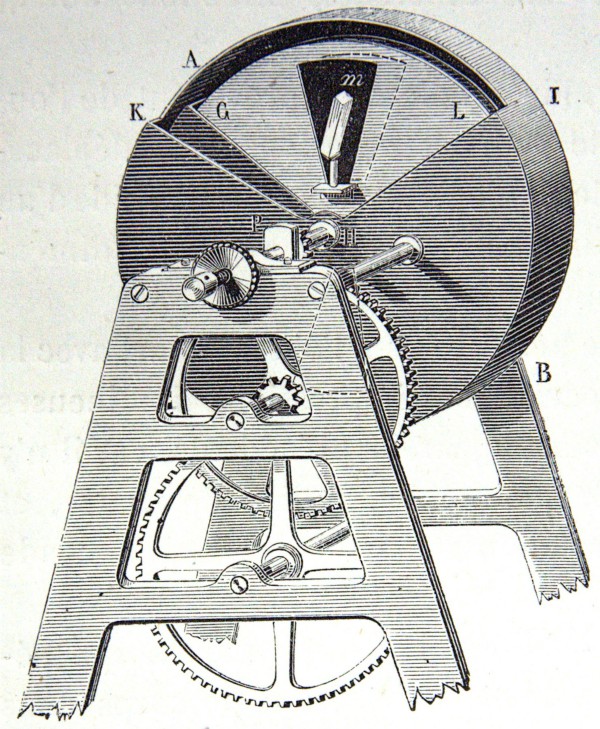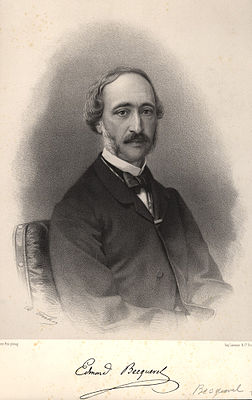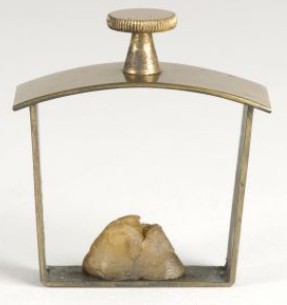
This instrument was invented by Edmond Becquerel in 1857, and the design developed during the eighteen sixties. It enabled him to see very short lived phosphorescence in minerals. Since fluorescence and phosphorescence are only time-defined identical phenomena, his phosphoroscope led him to discover that fluorescence has a decay time. Here’s a description of the device, from Popular Science Monthly, 1874 -



Becquerel developed the phosphoroscope to accurately measure the time between the excitation of a phosphorescent mineral, and the extinction of the glow. The specimen is placed between two, axially connected, rotating disks. A series of sector holes are cut from the disks, spaced at equal angles, a given distance out from the axle. The sector holes in one disk do not line up with the sector holes in the other disk. The disks and specimen are within in a light-proof circular enclosure.
This enclosure is pierced on both sides with single sector holes, facing each other, with the specimen between them. When the axle is rotated the disks spin, resulting in the crystal being alternately excited by light coming in through one hole, and viewed by the phosphorescent light coming out of the other hole. At no point do the sector holes all line up, so the observer never sees the source of excitation light. Varying the speed of rotation makes it possible to measure the short time interval during which the phosphorescent light is emitted. The mechanism was capable of resolving time intervals as short as 8 x 10-4 sec.
Becquerel wanted the maximum possible rotational speed from his phosphoroscope. The faster it turned, the more “back in time” he could observe, enabling him to see rapidly decaying phosphorescence. This required very finely made mechanisms, something that was undertaken by the Paris instrument maker Louis Jules Duboscq. He was a busy lad knocking out these precision machines, and some of his work can be seen later in this document.
To really appreciate the depth that Becquerel investigated the subject of phosphorescence, it’s necessary to read his his book, La Lumière, ses causes et ses effets. Unfortunately this is written in what appears to be some sort of foreign language, but selecting areas of promising looking text enables automatic translation in Google books! Good luck. Some of Becquerel’s words have been translated, this snippet, below, is from the rather ominously titled “Researches on Various Luminous Effects, which Result from the Action of Light on Bodies,” The Chemist, 1857 -




__________________
A Modern Phosphoroscope for Mineral Collectors & Research
The complexity and need for precision alignment of the mechanisms is overcome with the innovative design of the desktop e-Rocks Phosphoroscope. Having only one moving part - a single spinning disk, powered by a brushless, battery driven motor, it is simple and robust. No cranking, no cogs. The rotation speed is adjustable by the one control knob. The interval between illumination and viewing is shown, in milliseconds, on an OLED display. The e-Rocks phosphoroscope is of high speed, enabling much faster phosphorescence to be viewed and recorded, compared to the design of Becquerel. The user can choose their own source of illumination: sunlight, 50W bright white COB LED spotlight, SW or LW UV, Convoy 365nm flashlight (no need for filter), the e-Rocks Full-Spectrum Spark Discharge Flash, whatever they have at hand. Eyeball or digital camera set on long exposure, to record the phosphorescence. Retail price, well under £300.
Two other e-Rocks Phosphoroscope models are envisaged. Both would incorporate built-in ultraviolet (395nm) LED illumination. One would have a simple, single-speed rotating disk shutter, with precisely synchronised electronic timing of the UV illumination. This would enable a fluorescent mineral enthusiast to view the phosphorescence of specimens, simply and cheaply (<£150). The other model would be a probe, to be held against the surface of a mineral specimen. This version, having no moving parts, simply plugs into a laptop’s USB. It would not offer any view of phosphorescence, simply recording its phosphorescent decay curve, with a resolution of tens of microseconds, to be displayed as a graph on the laptop. This version under £75.
On a purely speculative note, an extremely inexpensive version could be possible. The e-Rocks Phosphoroscope Glasses. A combination of two cheaply available items - 3D Shutter Glasses (eBay £3.99) and a torch - 51 LED Flashlight UV 395nm (eBay £6.79). Relatively simple modification of these devices, together with about a tenner’s worth of electronics and the cost of a small electronics enclosure, could result in something usable, and highly desirable by those collectors interested in light-emitting mineral specimens.
3D shutter glasses normally work by receiving an IR signal coming from a 3D TV, then alternately black out the lenses so that each eye is seeing a different frame of video to create the stereoscopic effect. Bypassing the glasses’ electronics, both lenses could be blacked-out simultaneously, at the control of a small black-box. Similarly, bypassing the on-off switch of the cheap UV torch (or expensive Convoy 365nm flashlight), would enable the same black-box to control the light.
When the mineral specimen is being illuminated, the glasses are dark. When the illumination is off, the glasses are clear. If this switching is done very rapidly, persistence of vision enables phosphorescence to be seen. Unfortunately liquid crystal light valves, the lenses of the glasses, aren’t completely opaque when switched on. This would allow a little bleedthrough of the illumination. Also, the switching time is about 2ms, which may result in “only” being able see phosphorescence lasting longer than this (perhaps >20ms). These issues are of less concern with high-speed e-Rocks Phosphoroscopes, utilising mechanical, rotating, totally opaque shutters. Whether this (about 5% bleedthrough) would be a great problem with the glasses, will remain only to be determined by experimentation…...
We have the expertise and enthusiasm here at e-Rocks to prototype and develop such devices. If commercially produced, they would offer a new window of observation & investigation to all mineral collectors interested in fluorescence.
Watch This Space!
________________
From The Columbia Encyclopedia, 6th ed., a little about the inventor of the phosphoroscope, and his scientific family -

BECQUEREL (bek?rel´), family of French physicists. Antoine César Becquerel, 1788–1878, was a pioneer in electrochemical science. He was professor of physics at the Muséum d'Histoire naturelle from 1838 until his death. Becquerel made a special study of the voltaic cell, telegraphy, and magnetism and wrote several books on these subjects. His second son, Alexandre Edmond Becquerel, 1820–91, succeeded his father, in 1878, as professor at the Muséum d'Histoire naturelle. Known for his studies in light, photochemistry, and phosphorescence (for which he invented the phosphoroscope), Alexandre wrote La Lumière, ses causes et ses effets (1867–68). His son, Antoine Henri Becquerel, 1852–1908, was professor at the École polytechnique, Paris, from 1895. He studied atmospheric polarization and the influence of the earth's magnetism on the atmosphere. In 1896 he discovered radioactivity in uranium [sic. actually he discovered that pitchblende was radioactive, later determined as mostly due to radium & other daughters]; the Curies made further investigations of the phenomenon and shared with Becquerel the 1903 Nobel Prize in Physics.
Here’s some illustrations of the complexity of Becquerel's Phosphoroscope, for those with a penchant for the Industrial Revolution’s mechanical ingenuity! Starting with a fine hand-held Becquerel Phosphoroscope, from the Collection of Historical Scientific Instruments, at Harvard University. Maker: Louis Jules Duboscq, Paris, circa 1867. Dimensions: 13 x 17 x 15 cm. -















References -
La Lumière, ses causes et ses effets. Alexandre Edmond Becquerel, 1867
Researches on Various Luminous Effects, which Result from the Action of Light on Bodies, Alexandre Edmond Becquerel, The Chemist, 1857
The Time Interval between Absorption and Emission of Light in Fluorescence, R.W.Wood, 1921
Synchrono-phosphoroscope, page 38, Fluorescence of the Uranyl Salts, Nichols & Howes, 1919